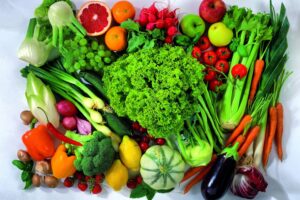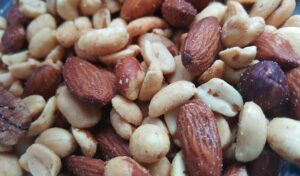
Eating well doesn’t happen by accident.
You have to plan balanced meals, which requires some preparation.
What are balanced meals?
Balanced meals contain all of the macronutrients: lean protein, carbohydrates, and healthy fats.
When meals contain all of the macronutrients, you’ll have
- greater variety of nutrients needed for good health
- better control of blood sugar
- increased feeling of satiety
- an easier time losing weight
- fewer cravings for sweets
I coach my clients to use their hand when estimating portion sizes because it’s easy to do and adjusts to the size of your body since you’re using your own hand.
For example, a serving of protein is a palm sized portion or 1 scoop of protein powder. The size of your thumb is a serving of fat, your fist is a serving of non-starchy veggies, and a cupped hand of fruit or starches.
Lean Protein
Proteins are made up of amino acids and helps our immune system, helps us repair tissues like skin, muscles, hair and bones.
Lean proteins include a palm-size portion of meat, poultry, fish & seafood, eggs, cooked beans & lentils, and cottage cheese or plain yogurt.
Also, a scoop of protein powder.
Colorful Veggies

Enjoy an unlimited amount of non-starchy veggies in a variety of colors. More colors = more nutrients.
A portion is the size of your fist, but eat as much as you want of these foods. You don’t have to starve yourself to lose weight!
These foods include asparagus, broccoli, brussels sprouts, cabbage, cauliflower, cucumber, celery, eggplant, green beans, kale, mushrooms, peppers, snow peas, spinach and other salad greens, zucchini or other summer squash, tomatoes, water chestnuts.
Fruits, Starches, and Grains

A cupped hand portion of fruits, grains, or starchy root veggies also belongs on your plate, especially at lunch and dinner.
These foods are good sources of fiber, provide energy and lots of vitamins.
They include legumes, rice, corn, potatoes, winter squashes, carrots, beets, peas and all fruits.
Healthy Fats

Round out your meal with a thumb-size serving of healthy fats like avocado, nuts and seeds, grass fed butter, olives, coconut milk, and oils.
Fats supply essential fatty acids which our bodies can’t make, vitamins A, D, E and K, and are a good source of energy.
Plan Balanced Meals
Now you just put it all together.
How many servings of each macronutrient depend on your health status, activity levels, and goals. But start with at least one serving from each group.
If you’re not sure what’s appropriate for you (for example, you’re a diabetic or on a special diet for medical reasons), check with your Doctor or licensed Nutrition professional.
Still hungry?
Load up on more non-starchy colorful veggies.
Want more help?
If you’d like more help learning how to plan balanced meals, check out my FREE 5-day email course. You can sign up below.
You can also get more in-depth coaching to help make planning balanced meals an established habit. I offer a 3-month online coaching course: Plan Balanced Meals Quick Start, or we also cover it in the year-long Comprehensive Healthy Habits Overhaul program.
Contact me today if you’d like to discuss which option is best for you!
